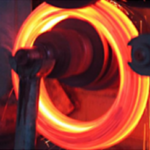The accessory belt tensioner powers a car’s air conditioning, water pump, alternator and power steering by maintaining tautness of the engine serpentine belt. A tensioner is available as one of three designs:
- pulley mounted on a spring mechanism
- pivot point for mechanical adjustment
- hydraulic
The hydraulic belt tensioner requires more engine space as it is designed for high loads and high angular vibrations
Belt tensioner bushing’s role
The bushing prevents metal-to-metal contact between the arm and spring housing. When the belt is operating efficiently, it allows the transfer of power without noise, vibrations or harshness – commonly referred to as NVH.
Bushings also allow the pulleys to rotate smoothly and maintain proper tension in the belt.
Material used to make belt tensioner bushings
Considering that the bushings must perform in high temperatures and under high-frequency oscillating motion, bushing materials are generally comprised of low carbon steel with a self-lubricating layer of Teflon or PTFE composite.
Some manufacturers use PTFE tape as opposed to curing the self-lubricating layer to the bushing. A downside of tape is that it can separate from the bushing due to the high temperature range. Heat is also an issue if the bushing is comprised of a plastic composite.
Signs of a failing belt tensioner bushing
Belt tensioners and the bushings can wear for a number of reasons including a belt that is too loose or too tight. Early warning signs include:
- Squeaks or grinding noises
- When accessories that rely on the belt for energy start to fail
- If misalignment can be seen on a tensioner arm
- Resistance in the tensioner
It is more economical to replace the entire belt tensioner than just the bearing.
The bottom line: While bushings may be a small component in the overall design of a belt tensioner, they play an important role in maintaining a functional accessory system.


